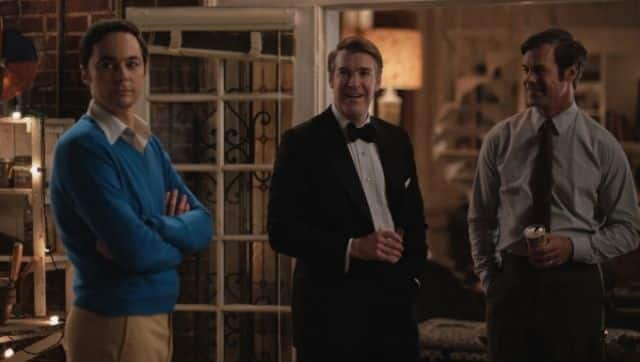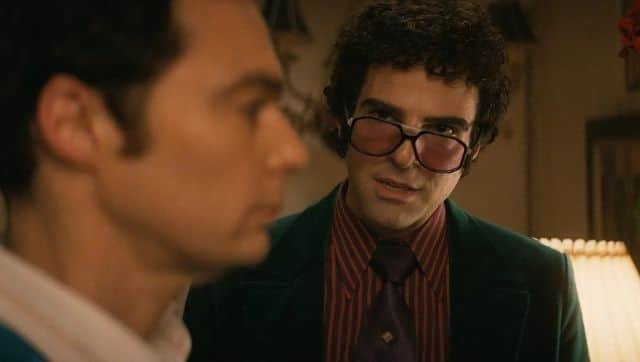“As my father said to me when he died in my arms, ‘I don’t understand any of it. I never did’.” Michael’s (played by Jim Parsons) final words in his apartment ring true by the end of Netflix’s The Boys in the Band. Adapted from Matt Crowley’s seminal 1968 play, this Joe Mantello directorial reunites some of Broadway and television’s favourite men. Much like the play, the film begins on a peppy note with preparations for a birthday party at Michael’s plush Upper East Side apartment, where seven homosexual men plan to meet and have a jolly dinner together. Placed in the heart of the US liberal reformation, The Boys in the Band always stood as a crucial piece of art for the LGBTQ+ world. But more importantly, Mantello’s treatment gives a fabulous inlet into this marginalised space. Carefully layered and poignant, the two-hour feature minutely decodes the years of systemic ostracisation that the community has faced. Through the characters’ forms of expression and insecurities, Mantello underlines the othering that resulted in acute self-loathing and venomous cynicism. The lot, which includes Harold (Zachary Quinto), Donald (Matt Bomer), Larry (Andrew Rannells), Emory (Robin de Jesus), Bernard (Michael Benjamin Washington), and Hank (Tuc Watkins), gather for an innocuous occasion to celebrate Harold on his 32nd birthday. The frolic begins early on, with yellow lights, sumptuous alcohol, and breezy music. But they are soon faced with existential crises that threaten to topple their dynamics. Michaels’s cosy apartment thus forms the stage where the “band” drink to glory, make eyes, pick scabs, throw shade, and lick wounds. [caption id=“attachment_8869301” align=“alignnone” width=“640”] The Boys in the Band is based on Matt Crowley’s seminal 1968 play of the same name[/caption] The group’s multi-dimensional politics take centre-stage from the moment they are introduced on-screen – histories are uncovered and lost loves revealed. The Boys in the Band is a cultural snapshot of an earlier and more repressed time that speaks volumes to the present. Mantello’s intelligent treatment gives the film its required datedness. The men are stylishly adorned with bell bottoms and monochromes. The emotionally stunted lot oscillate between brief moments of confessing their love for each other followed by expressions of deep-seated anger, a fact seen especially in Michael. He spews venom at his best friends, all the while, ensuring that everyone has a “good time” at his painstakingly curated birthday party. He shies away from any affection, but derides the world for being distant to him. He is such a stickler for habit that his obsession to conform to “butch” standards to pacify his closeted heterosexual friend Alan is quickly transformed into a debilitating game just to expose Alan’s ‘true self.’ [caption id=“attachment_8869311” align=“alignnone” width=“640”]
 Michael (far left, played by Jim Parsons), thrives on self-doubt and loathing while still appearing as the perfect friend on the outside[/caption] His lifelong struggle to come to terms with his own sexuality finds fissures to escape at every juncture — while he scoffs and curses his way to a complete breakdown. Contrary to this drunken state of pessimism, Michael’s sober self is plain self-evasive and perky, desperately trying to busy himself so as to not ruminate. Almost as a veritable contrast to this is Harold and his calm. A gay Jew, Harold deals with a constant need to starve himself through the day, only to gorge on a single meal by the end of it. Michael’s acerbic statements are met with equal jibes by Harold — almost like the two were in an intense fencing match, only their bodies replaced by their egos. [caption id=“attachment_8869291” align=“alignnone” width=“640”]
Michael (far left, played by Jim Parsons), thrives on self-doubt and loathing while still appearing as the perfect friend on the outside[/caption] His lifelong struggle to come to terms with his own sexuality finds fissures to escape at every juncture — while he scoffs and curses his way to a complete breakdown. Contrary to this drunken state of pessimism, Michael’s sober self is plain self-evasive and perky, desperately trying to busy himself so as to not ruminate. Almost as a veritable contrast to this is Harold and his calm. A gay Jew, Harold deals with a constant need to starve himself through the day, only to gorge on a single meal by the end of it. Michael’s acerbic statements are met with equal jibes by Harold — almost like the two were in an intense fencing match, only their bodies replaced by their egos. [caption id=“attachment_8869291” align=“alignnone” width=“640”] Harold (Quinto) is the perfect match for Michael’s pessimistic approach to life[/caption] Nothing major happens. Yet, the tensions built, require ample time to dissipate. Hank and Larry (a couple) try to come to terms with their respective ideas of loyalty; Emory addresses the issue of constantly trying to Uncle-Tom Bernard; Donald attempts to decode Michael and provide him with a supportive shoulder to cry on (literally as well), and Alan furiously beats Emory hours before confronting his sexuality. All the men in the room grapple to hold on to the shreds of sanity that they developed over the years, trying earnestly to make sense of their feelings, intuitions, and inner voices. Each defends the other, but do not hesitate to pull each other down on occasion. Their mutual love is the personification of an oxymoron, one that even boggles the people practicing it. Thematically akin to Edward Albee’s play A Delicate Balance, the characters in the boys’ band strive each day to keep sane, keep smiling, and be hopeful. Mantello artfully ends the film on an introspective note, clearly depicting each character’s arc as they leave the party. Their self-esteem in tatters, they build themselves up yet again, maybe even a little lighter after the outbursts. The Boys in the Band transcends beyond being a socio-cultural mouthpiece for homosexual individuals. It’s a film about self-doubt, love and friendship, matters of the heart that all of us have had our trysts with. The Boys in the Band is currently streaming on Netflix. Rating: ****
Harold (Quinto) is the perfect match for Michael’s pessimistic approach to life[/caption] Nothing major happens. Yet, the tensions built, require ample time to dissipate. Hank and Larry (a couple) try to come to terms with their respective ideas of loyalty; Emory addresses the issue of constantly trying to Uncle-Tom Bernard; Donald attempts to decode Michael and provide him with a supportive shoulder to cry on (literally as well), and Alan furiously beats Emory hours before confronting his sexuality. All the men in the room grapple to hold on to the shreds of sanity that they developed over the years, trying earnestly to make sense of their feelings, intuitions, and inner voices. Each defends the other, but do not hesitate to pull each other down on occasion. Their mutual love is the personification of an oxymoron, one that even boggles the people practicing it. Thematically akin to Edward Albee’s play A Delicate Balance, the characters in the boys’ band strive each day to keep sane, keep smiling, and be hopeful. Mantello artfully ends the film on an introspective note, clearly depicting each character’s arc as they leave the party. Their self-esteem in tatters, they build themselves up yet again, maybe even a little lighter after the outbursts. The Boys in the Band transcends beyond being a socio-cultural mouthpiece for homosexual individuals. It’s a film about self-doubt, love and friendship, matters of the heart that all of us have had our trysts with. The Boys in the Band is currently streaming on Netflix. Rating: ****
Adapted from Matt Crowley’s seminal 1968 play, The Boys in the Band follows the lives of a group of gay friends over a night’s celebration
Advertisement
End of Article
Written by Shreya Paul
A Theory of Communications enthusiast still learning social skills. Forever curious about the effects of good food on grumpy people. see more


)
)
)
)
)
)
)
)
)



